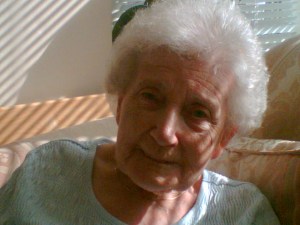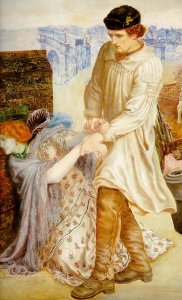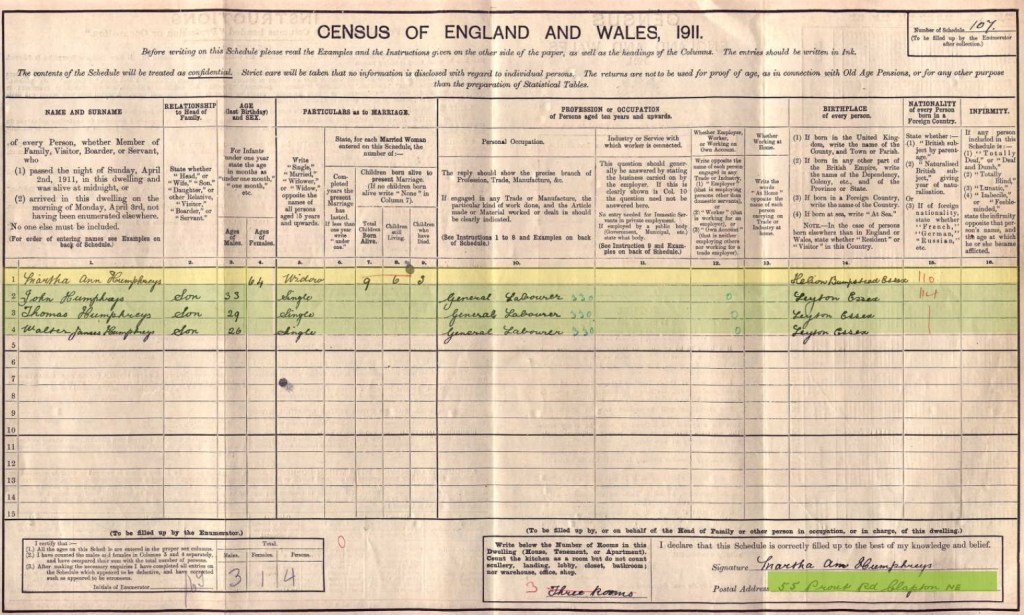By Christine Swan
I was so privileged to have been able to spend time with my mum’s eldest sister, Ethel, in her latter years. She was an incredible lady who loved to recount her childhood memories with me just as much as I enjoyed hearing them. She helped me to understand the characters that I write about and gave me insights into their personalities that I could never deduce from historical documents alone.
My aunt Ethel was born in 1913 , and her grandmother, Martha, had moved in with the family after she was widowed and her grown up sons had moved out. While her daughter became a loving and kindly granny, who was adored by all of the family, and a huge help and support to my aunt and her daughter, Martha, was a different personality altogether. “She called us varmints!”, my aunt recounted to me. All of the Apthorp girls were petite and delicate but Martha was tall and very stern. She used to chase the children out of the way with a broom. With her hair scraped back and black attire, her charges formulated the belief that she was a witch. Martha had a secret store of biscuits for her personal consumption but this turned out to be rather insecure. My aunt and her siblings soon discovered the location of the cache and used to help themselves, only taking enough to satisfy their needs but not so much as to arouse suspicion. “She never found out”, chuckled my aunt conspiratorially.

Aunt Ethel
I found this rather hard to digest. The only grandmother I had ever known was my paternal, who was a warm and loving lady, and would definitely have shared her biscuits. In fact, she would have insisted that I had the last one. My maternal grandmother was just the same according to my mum. She told me often how much she missed her and what a lovely lady she was.
However, my maternal grandmother had one bone of contention with her own mother. When she was thirteen years old, like so many young girls, she was put into service. One of her first tasks was to pluck chickens and she cried continuously while doing it. She was given the dirtiest, most menial tasks, as the most junior member of the downstairs staff. My grandmother had a miserable time, missed her siblings and yet still showed generosity in taking her mother into her home in her old age.

Granny and Grandad Apthorp
Martha Ann Malyon was born in October 1845 in Helions Bumpstead, Essex. Her parents, Stephen and Esther, were farming folk. 1851 found the family living in Clap House Yard. The eldest boys of the Mallyon clan were all agricultural labourers. Martha learned a trade as she grew and is recorded as both a shirt and jacket maker. This would have been skilled work and she would have worked with fabrics such as linen and calico. One traditional farming garment from this era is the smock. This practical and all-encompassing garment would have provided protection from the elements without fiddly fastenings. Smocks also provided a canvas for embellishment in the form of smocking and embroidery. This would provide some fit to an otherwise baggy garment but stitches and designs also reflected the area of origin as well as the designer’s interpretation.

A romantic view of a shepherd’s smock from Dante Gabriel Rossetti, 1854 Public Domain, https://en.wikipedia.org/w/index.php?curid=5233718
As detailed in my last family history blog, Martha Ann Mallyon married Charles Humphrey in 1870. After living firstly with her father Stephen, the couple moved to Leyton, Essex, close to the River Lea. After Charles’ death in 1897, Martha moved, with her three youngest boys – John, Thomas and Walter, to the delightfully named Pleasant Place, on the banks of the river, next to the Kings Head pub. This was close to Reader’s boathouse where boats could be hired to row the river. Rowing was a very popular sport in the nineteenth century for both men and women, even my grandmother joined a local club.

The Humphrey(s) family in 1871 living in Helions Bumpstead
A discovery of Martha’s name on an electoral register piqued my interest. Surely women did not yet have the vote? But these were not registers for general elections. Women were able to vote in municipal council elections and could be elected to school boards. I already know that Martha was a feisty lady and I hope that she used her vote wisely. She did live to see women gain equal rights in voting later on.

Humphrey family in 1901 in Pleasant Place, Lea Bridge
In 1901, Martha was working as a charwoman. Presumably there was no work as a jacket and shirt maker, or perhaps her specialism was in country wear, rather than work clothes for urban life. John, Thomas and Walter were also working as general labourers. In 1911, Martha and the boys had moved further back from the River Lea to Prout Rod. The 1911 census is an interesting one because it was the first to be completed by the householder and includes additional information, such as how many rooms the family occupy, how many years of marriage they had completed, and whether any of their children had died. The Humphrey or Humphreys family lost three of their nine children. This is a sobering statistic, a third of the family’s children did not survive.

Humphrey family in 1911, Prout Road, Clapton
1921 found Martha living with her daughter Dora and husband Charlie, along with four of the varmints. Ethel, aged seven at the time, was chief varmint. One of Martha’s sons, John, aged forty three, and still single, was also living with his sister, and her family in Wetherden Street.
Martha died in 1925, at the grand age of eighty. She strikes me as a determined and forthright woman. I am sure that my aunt’s memories must have held some pleasant memories too. But, she did like to weave a tale and I lapped up every small detail.

Aunt Ethel holding a very small me, at my christening
All original photographs property of the author



Leave a comment